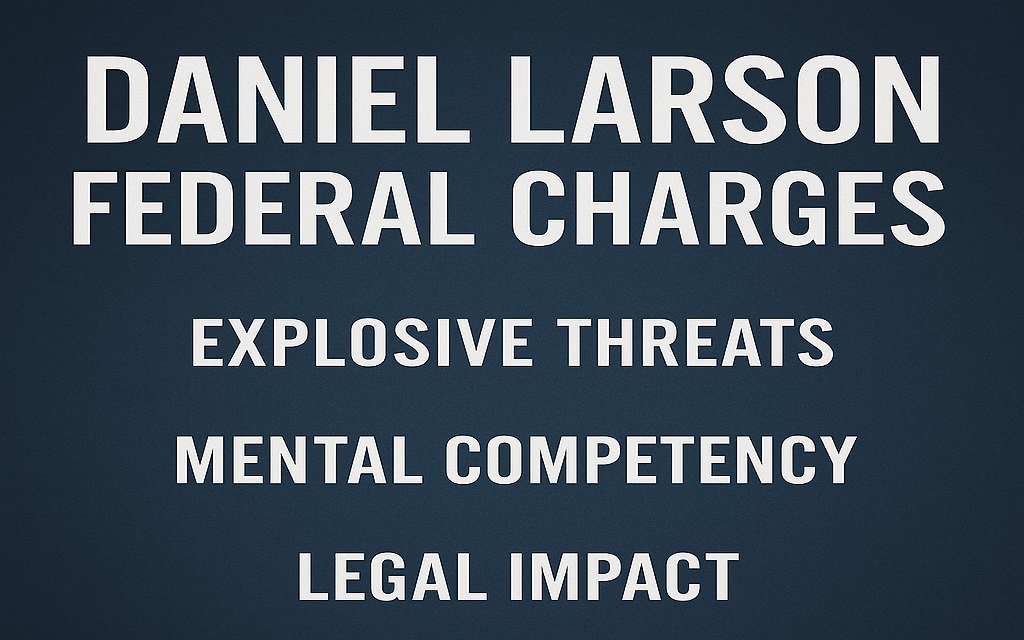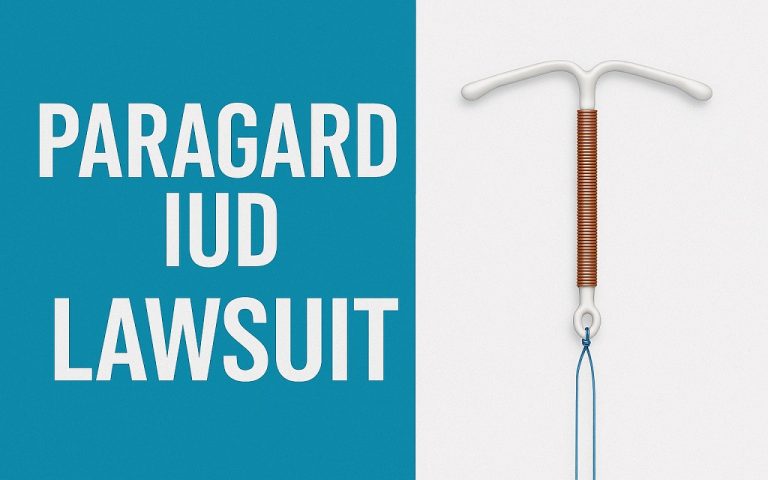You need to know that the Daniel Larson lawsuit is not just another criminal prosecution. Federal investigators uncovered multiple threats associated with his name across various digital platforms. You should understand that those threats involved bombings and violence against public institutions. The FBI acted quickly. Prosecutors filed serious federal charges. This case now raises concerns about online safety, mental health, and the law’s response to digital threats.
Who is Daniel Larson, and Why Is He Facing Federal Charges?
The first thing you should do is learn about Daniel Larson. He is a 26-year-old Colorado native. He was accused of threatening violence by federal officials. His situation is now being discussed in terms of national security. Following the release of several concerning texts in late 2023, his name was included in FBI affidavits.
Official court documents show that Larson is charged with seven felonies, including one count of interstate communication of threats to a federal officer and six counts of using explosive threats.
However, because of the targets’ varied locations—from a charity centre to federal buildings—this case has attracted national attention. However, the use of modern communication tools to issue these threats is. As such, Larson’s case represents a disturbing intersection of mental health, digital communication, and domestic threat assessment by federal authorities.
What Charges Does Daniel Larson Face?
It is essential to note that Larson faces seven federal charges. You can break them into two categories:
- Six counts under 18 U.S.C. § 844(e)
- One count under 18 U.S.C. § 875(c)
You should note that section 844(e) relates to threats involving explosives. Section 875(c) deals with threats sent across state lines. The law applies regardless of whether an actual device exists.
Where Were the Threats Directed?
You should know that Larson’s threats were serious and specific. Authorities say he targeted multiple places:
- A federal courthouse in Denver
- A threat to bomb a U.S. District Courthouse
- An LGBTQ+ nonprofit center in Boulder
- FBI headquarters in Washington, D.C.
- A college campus in Colorado Springs
- A state government building in Colorado
- The White House
Each threat came through email or anonymous digital platforms. One message warned of mass violence at a federal institution. Another declared intent to bomb a government facility. The threats led to evacuations and heightened security in affected regions.
How Did the FBI Respond?
It is crucial to learn that the FBI used digital forensics to trace Larson. Agents tracked IP addresses through VPN logs. Subpoenas to internet providers linked devices to Larson’s residence. Metadata from multiple accounts showed a consistent pattern. You should know that this led to his arrest in May 2024. A grand jury indicted him in April 2024.
What Does the Case Timeline Look Like?
You should understand the key dates that define the case:
- July 2023: First threatening email detected
- October 2023: Multiple targets threatened in succession
- December 2023: FBI begins digital tracing
- March 2024: Final communication received
- April 25, 2024: Federal grand jury issues indictment
- May 1, 2024: Larson appears before Judge Kathryn Starnella
- June 2024: Mental health evaluation begins
- July 2024 (projected: Case review and decision on trial resumption
The case remains active in the U.S. District Court for the State of Colorado.
Must Read: Janel Grant Lawsuit: WWE Abuse Claims, Sex Trafficking Allegations, and Legal Fallout
What Penalties Could Larson Face?
You must understand the legal risks Larson faces. Each of the six explosive threat charges could lead to:
- Up to 10 years in prison
- A fine of up to $250,000
The additional charge under section 875(c) could result in:
- Up to 5 years in prison
- A fine of up to $250,000
Combined Total Exposure:
- Up to 65 years in prison
- Up to $1.75 million in fines
- Mandatory supervised release upon completion of the sentence
Altogether, Larson may face up to 65 years if convicted. You should be aware that federal sentencing is strict. Judges follow the U.S. Sentencing Guidelines unless mitigating factors apply.
What Role Does Mental Health Play in the Case?
It is essential to know that Larson was declared incompetent to stand trial. A federal judge made this ruling after a psychiatric evaluation. Court documents reveal signs of severe delusional disorder. You should consider how mental health affects federal trials.
However, federal law, as outlined in 18 U.S.C. § 4241, permits the court to assess a defendant’s mental capacity if there is reasonable cause. Larson’s behavior, combined with the nature of his messages, prompted legal counsel and the court to consider whether he understood the charges and was capable of participating in his defense.
How Does Federal Law Handle Competency?
You must understand the process. Courts follow 18 U.S.C. § 4241 to decide if a person can face trial. If a defendant cannot understand the charges or assist legal counsel, the court pauses proceedings. Judges often order treatment or observation.
A federal psychiatrist at FMC Butner provided a preliminary report. The report indicated that Larson believes he is under government surveillance by satellites. The judge agreed that he lacks rational comprehension of the proceedings.
How Did Federal Authorities Track and Arrest Larson?
According to the FBI affidavit, Larson used email addresses and online aliases to send his messages. Digital forensics and IP tracing tools were used to trace the threats back to internet service accounts in Colorado.
Federal prosecutors, local law enforcement, and the FBI collaborated to coordinate the arrest. Despite some communications being sent through anonymous platforms, a warrant was obtained after sufficient digital evidence linked Larson to the threats.
What Comes Next for Larson?
The court will likely review his mental status again. You may expect a second evaluation. If Larson is found competent, trial proceedings will resume. Please note that a plea agreement remains a possibility. His defense attorney has not ruled out requesting conditional release into a secure facility.
What Happens Next in the Daniel Larson Lawsuit?
The following steps will depend heavily on the outcome of the competency evaluation. If Larson is found competent to proceed, a trial date will be set in federal court. If not, he will remain in a medical facility for continued observation.
Key possibilities such as:
- Pretrial resolution: The matter can be settled without a trial if Larson’s attorney and the prosecution agree to a plea deal.
- Involuntary commitment: Larson may be detained forever in a secure mental health facility under federal control if he is determined to be irreversibly incompetent.
- Trial and sentencing: If the defendant is competent, a trial will proceed under the original seven-count indictment.
Are There Any Similar Legal Cases?
You should be aware that similar cases exist. In 2016, a man in Oregon sent digital threats to a U.S. senator. He was charged under the same statute, 18 U.S.C. § 875(c). Courts sentenced him to 4 years. In 2022, a woman in Texas emailed threats to a college dean. She received a 7-year prison sentence in federal prison.
Those cases did not involve explosives. Larson’s threats involve physical harm and mass casualties. This increases the seriousness and expected sentence.
What Makes the Case Unique?
You should consider the public reaction. Online users discuss Larson’s behavior on platforms like Reddit. Some raise concerns about public safety. Others debate the intersection of mental health care and the criminal justice system. Media coverage has grown since the indictment.
Experts say Larson’s case reflects a larger pattern. Anonymous threats have increased 42% from 2020 to 2024, according to FBI statistics. Law enforcement must assess the real risks posed by digital messages.
What Lessons Can You Take From This?
You should think carefully before posting online. Even anonymous threats can lead to federal charges. It is crucial to avoid using threatening language. You must understand that digital footprints are traceable. Law enforcement agencies partner with social platforms for faster responses.
Expert Opinions on Daniel Larson Federal Charges
Legal analysts suggest that the outcome of Larson’s case will likely depend on:
- His mental health evaluation results
- Whether prosecutors accept a plea bargain
- The level of credible danger implied in his threats
According to former federal prosecutor Amanda Clark, “Cases like Larson’s are becoming more common as mental health, social media, and online anonymity intersect. However, federal courts must balance public safety with constitutional rights and treatment needs.”
What Does the Law Say About Online Threats?
You should be aware that U.S. law takes all credible threats seriously. Federal agencies have the authority to prosecute even if no action is taken to address the danger. You should remember that intent matters less than public risk. Courts assess the context and clarity of the message.
What Do Legal Experts Say?
Experts suggest that Larson’s case may set a precedent. You should consider how courts weigh mental illness against public danger. Former prosecutor Amanda Clark says federal courts must strike a balance between safety and rights. She adds that mental health defenses must be based on evidence, not assumptions.
Legal scholar Dr. Henry Lowell of Yale Law School states that digital threats represent a growing problem. His research reveals that more than 1,300 cases of online threat prosecution were reported in 2023 alone.
Why Should You Care About This Case?
You must care because it reflects modern legal challenges. As more individuals use online platforms, the number of digital hazards increases. You should be aware that law enforcement is adapting to the use of AI and natural language processing techniques. The government and platforms are more closely monitoring online discourse.
What Are the Broader Impacts?
You can expect this case to have a significant impact on future policies. Federal agencies may push for faster threat detection. Mental health screening in criminal cases may expand. You should consider the implications for free speech and digital safety. Congress may review statutes to improve clarity on digital threats.
What Can You Do to Stay Informed?
You should follow updates from court records and legal blogs to stay informed about the latest developments. It is wise to review the Department of Justice (DOJ) announcements. Use verified sources to track changes in the law. Lawfare Blog, SCOTUSblog, and DOJ.gov are reliable options.
Public Reactions and Online Discourse
Additionally, others have been speculating about Larson’s behaviour patterns, past offences, and mental health history on Reddit and TikTok after his name became viral. Many people voice concerns about public safety, but others question the morality of making mental illness a crime.
Conclusion
You must understand that the Daniel Larson lawsuit reveals serious legal and ethical questions. Federal charges, digital threats, and mental health are now deeply connected. You should stay informed and cautious in online spaces. The law protects public safety, and consequences are real. You must also reflect on how digital behavior can intersect with the justice system in unexpected ways.
Disclaimer: This article provides a general overview of the Daniel Larson Federal Charges, based on publicly available information, and is intended for informational purposes only. It does not constitute legal advice.




